Today I’m writing about 2 foods that I’ve never tried before – Lion’s Mane Mushroom and Sunchokes. I’ll be exploring the attributes of these two foods – appearance, flavour, texture – but first – a pug apron and side towel:

I was at a fundraiser for Pugalug Pug Rescue. There was a silent auction and these were one of the prizes I bid on.
The Lion’s Mane Mushroom
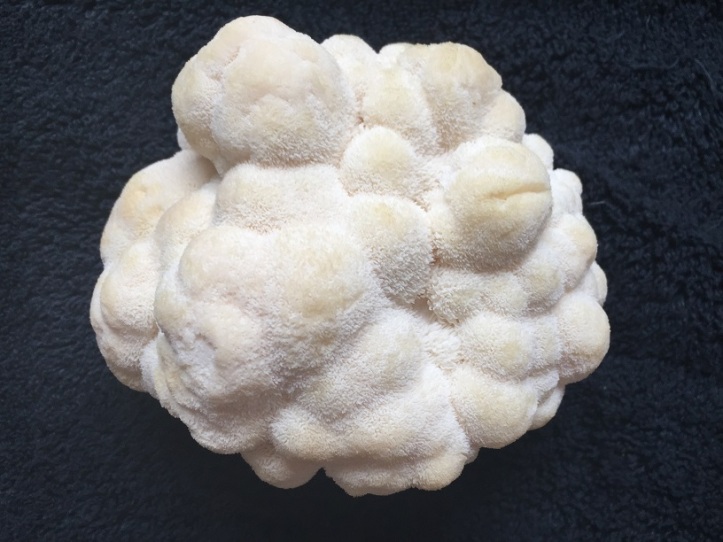
The Lion’s Mane Mushroom, also known as the Bearded Tooth Fungus, is a sight to behold. I was hunting in my favourite market – Evergreen Brickworks when I spotted one at the mushroom stall. I immediately stopped in my tracks. The appearance of the Lion’s Mane is unlike any other mushroom. It looks like a cauliflower with the white, bulbous segments. Looking closely you can see thousands of tiny teeth like bristles. Eventually these teeth will grow longer to release its spores.
It has the distinct, earthy aroma of a mushroom. Slicing a sliver and biting into it releases more water than I was expecting. They grow on trees so it is not surprising they are filled to bursting with moisture.
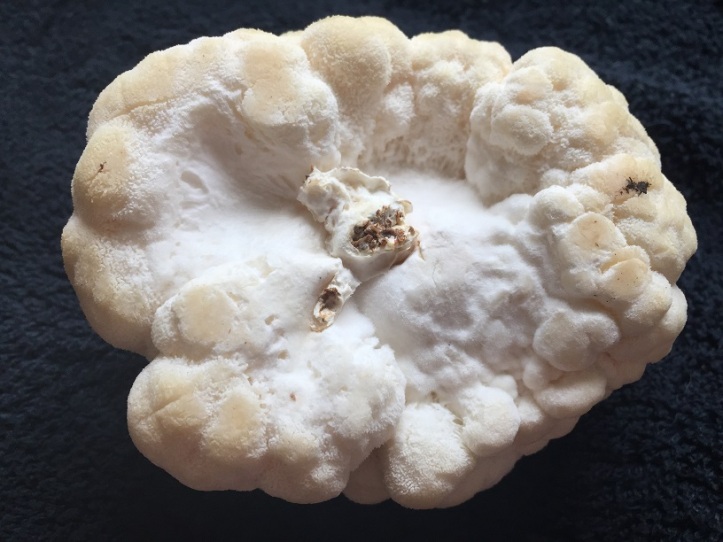
I’m going to be roasting it to remove the moisture. However, the raw slice has a chewy texture with a mild, mushroom taste. The “teeth” have a fuzziness on the tongue that makes for a delightful chew. It has a neutral taste in that it is not salty, sweet, bitter or sour. Flavour will have to be added during the cooking process.
I begin to segment the mushroom with a paring knife. Again, it reminds me of segmenting a cauliflower except it is much more quiet and smooth. It’s more like slicing sponge cake.

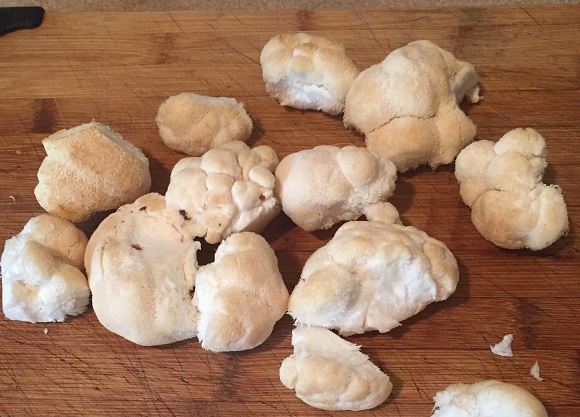
I’m going to roast these bulbs and serve them on a bed of sauteed sunchokes
Sunchokes
I first learned of sunchokes from my friend Chef David Wolfman. In his book “Cooking With the Wolfman” he says “It’s a species of sunflower that is indigenous to North America and has a long history of being prepared in soups by eastern woodlands First Nations.” It is also known as Jerusalem Artichoke and is the tubular root of the sunflower.
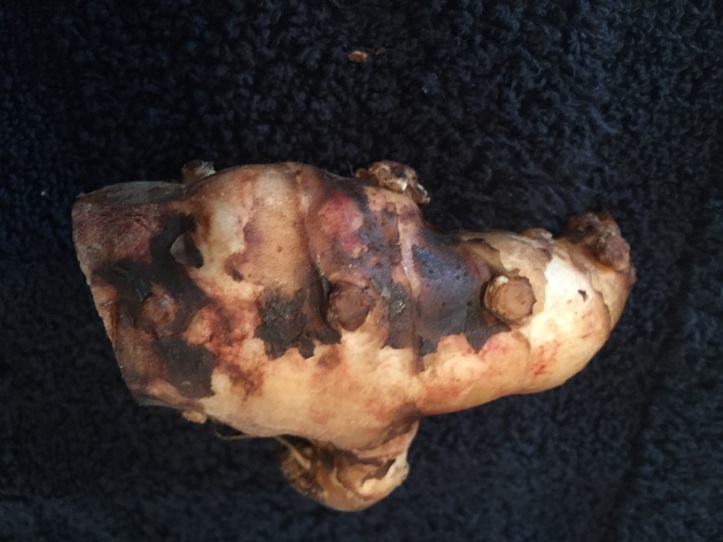
Chef Wolfman says they can be eaten raw in salads like radishes, with the skin on. Because both the mushroom and choke are white, I’m going to add colour in the cooking process.
The sunchoke’s appearance tells you right away that it is a root. The brownish skin is edible and nutritious but your decision whether you want to leave it on. In a salad the white flesh and brown skin can add a color contrast.
Like a potato, it does have “eyes” that you will want to remove. For this recipe I’m going to remove the skin. I’ll use the same technique I use on ginger and that is to remove it by scraping with a spoon.
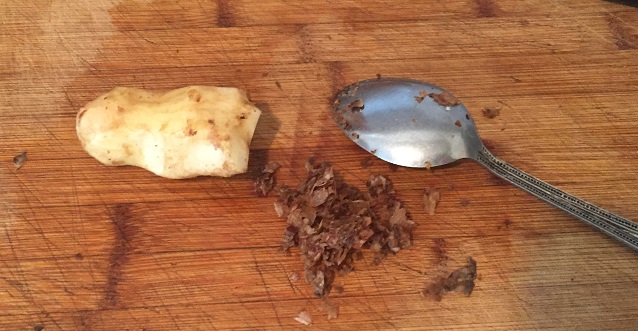
Like the Lion’s Mane, the sunchoke also has a neutral taste. It is mild and slightly woody. I’m going to cook the sunchoke in a red wine/sherry vinegar mixture. This will not only add flavour but change the color of the sunchoke. When it is served with the Lion’s Mane, the colour contrast will add to the appearance of the dish as a whole.
Slice lengthwise then julienne the choke.

Saute then add red wine and sherry vinegar and reduce.

Next I brown the mushroom bulbs is a tiny amount of oil. The caramelization of the heat give the bulbs a brown coat. I had a small pad of butter to each bulb then roast in the oven for about 5 minutes.

Both the sunchoke and the Lion’s Mane now have a distinctive taste, smell, colour and texture brought on by the cooking process.

And, for the pugs – a light coating of olive oil on the sunchokes then a quick fry on each side. Because of its shape, the chokes vibrate back and forth as they are heated. Movement of food while cooking is fascinating to watch. See here on Youtube

And we bring in a member of our focus group to try out the root. The crunchiness of the sunchoke will give Eve’s gums a workout.

Health Benefits
There are documented benefits to both of these foods:
The Top 7 for the Lion’s Mane
From this experience, using my palate, I learned how an unfamiliar food can be experienced for the first time. There are no preconceived notions on how it should taste. It is an exploration of the palate.
Because both have a neutral taste, flavour has to be added. In this case the tartness of the sunchoke saute balanced the butter of the mushroom. On their own, neither has a taste that can enjoyed.
In addition, I understood how to change a neutral food – one without any discernible salt or sweet taste – into a flavourful one. The change resulted in a very delectable dinner that I thoroughly enjoyed.
I will cook with sunchokes again. Chef Wolfman’s receipe in the book is a simple roasted sunchoke with garlic. I’ll also try his sunchoke potato salad.
The Lion’s Mane was very succulent. Even after roasting a fair amount of moisture remained which made it easy to chew. However, the cost makes it prohibitive to have on a regular basis. But I was glad to have supported a local mushroom grower.
The lesson here is to open the mind to foods beyond what you are use to. As to that, my next project will be on Balinese cooking – with spices like tamarind, lemongrass and galangal. However, I’ll practice a few dishes before I blog about it.
What an interesting blog. I assume that these mushrooms and sunchokes are not available in our regular grocery stores?
LikeLike
Yes Denise. The Lion’s Mane is from a mushroom grower’s stall at the Evergreen Brickworks Farmer’s Market. The sun chokes were at Whole Foods, imported from the US. They will be local late summer early fall
LikeLike
[…] of Portobello mushroom are often used as veggie burgers. In my previous post I have taken the Lion’s Mane, slathered in a cashew butter then roasted like a prime rib. Truly, the umami mushroom is an […]
LikeLike